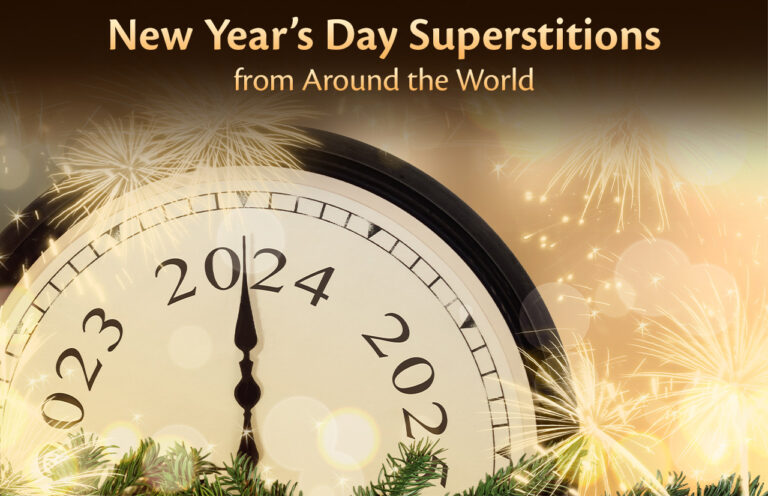Will you be kissing your sweetheart at the stroke of midnight on New Year’s Eve?
Will you be eating black-eyed peas and collard greens a few hours later?
Or perhaps walking around your home with an empty suitcase?
While some of these seem strange, there is always a lot of superstition centered around the start of a new year. Kind of makes sense, right? New year, new beginnings. A time to refocus all your energy and start some things anew. A calendar “do over” so to speak. Which is exactly why all the superstitions associated with New Year’s Day promise a payoff of good luck, prosperity, happiness and good health, a gift everyone can appreciate. Especially if you’re trying to follow through with all those New Year’s resolutions.
But where did these superstitions come from? The answer is often fascinating. And depending on where you are located geographically, there are distinctively different superstitions you may be personally accustomed to. In today’s blog, we will examine the history behind some of them with New Year’s Day Superstitions from Around the World.
Table of Contents
What Is a Superstition?
Most of us have heard people warn about walking under ladders, breaking mirrors or letting a black cat cross our path. Usually, this general caution becomes amplified around Friday the 13th, a very superstitious day on its own. But what is a superstition exactly?
A superstition is a non-scientific belief or practice founded in a good luck vs. bad luck narrative. The idea that people can do things (or not do things) that will affect a change in their life prompting fortune or misfortune. Very often, those who give credence to superstitions will practice specific routines or rituals, attributing magical or supernatural significance to certain actions, objects or events.
Though unfounded, empirically speaking, superstitions are given much credibility by many people across this planet. This may have to do with the cultural or historical roots of superstitions and our personal exposure to them; in other words, how they are presented to us through family traditions and our personal experiences.
Universal New Year’s Day Superstitions
There are quite a few universal superstitions surrounding New Year’s Day, but they can be narrowed down to 4 key categories: eating certain foods, wearing certain colors, avoiding certain activities and maintaining a certain disposition.
1. Eating Certain Foods: black-eyed peas, lentils, greens and cornbread are a few of the main foods thought to bring good luck, while crab, lobster, eggs, chicken and turkey are meant to be avoided.
2. Wearing Certain Colors: almond, purple and gold are considered lucky colors to wear on New Year’s Day, while black, white and green are not.
3. Avoiding Certain Activities: cleaning your home or accruing debts are just a few activities thought to be taboo on January 1. Those of us who don’t like the chore of cleaning are certainly thankful for that one! But if you want to have good luck in the new year, it begins promptly at 12:00 AM with a midnight kiss and lots of noise – fireworks and loud cheers – meant to drive away any negative spirits with positive energy.
4. Maintaining a Certain Disposition: there is really only one practice in this category but it’s a significant one – avoiding any negative behavior. This is the first day of a new year, so it is thought to be a crucial time in setting the tone for the rest of the 364 calendar days.
Origins of New Year’s Day Superstitions
Historically speaking, the origins of many New Year’s Day superstitions are rooted in ancient traditions, folklore and annual cultural practices, both pagan and Christian. Over time these have evolved, alongside the changes within civilizations and belief systems, but they remain a potent part of many modern societies.
Regional Differences in New Year’s Day Superstitions and Practices
Now that we’ve taken a look at superstitions in general and how they apply to New Year’s Day, let’s check out some of the interesting regional nuances from countries outside of the United States.
Spain – in Spain and in many other Latin American countries, people eat 12 grapes at the stroke of midnight – one for each month of the new year – to bring them good luck.
Japan – at the stroke of midnight, Buddhist temples in Japan ring their bells 108 times, meant to help purify believers from the 108 worldly desires and sins.
Philippines – because the shape of coins is round, people in the Philippines display round-shaped fruit and serve round-shaped foods on New Year’s Day to help generate prosperity for the coming months.
Turkey – pomegranates are a very superstitious fruit already, but in Turkey, the practice of breaking a pomegranate open on New Year’s Day is believed to promote good luck and foster fertility.
Scotland – Scots practice a tradition called first-footing, where the first person to enter a home after midnight is supposed to bring with them gifts of coins, bread, salt, whisky and coal, each one symbolizing a certain type of good luck.
Ireland – fire ceremonies are very popular in Ireland and involve a practice called “fireball swinging”. People sling around large flaming balls through the air in a ritualistic manner. The fireballs are meant to symbolize the sun and help to purify the coming year.
Italy – did you know red underwear was lucky? Italians certainly believe so. Every December 31 they put on red underwear so they can bring in a new year with prosperity and good luck.
Brazil – while the opposite is true in many other countries, the people of Brazil believe that wearing the color white will be beneficial to a new year. It symbolizes peace and purification.
Well, that was fun, don’t you think? What are your thoughts on New Year’s Day superstitions? Do you have any that you abide by? We’d love to hear about them in the comments. As the end of 2023 quickly approaches, we’d like to wish you lots of luck, prosperity, happiness and good health for the coming year. So, as you watch the ball drop on New Year’s Eve or count down the minutes with the people you love the most, we hope you have a big smile on your face as you and your family enter 2024.













